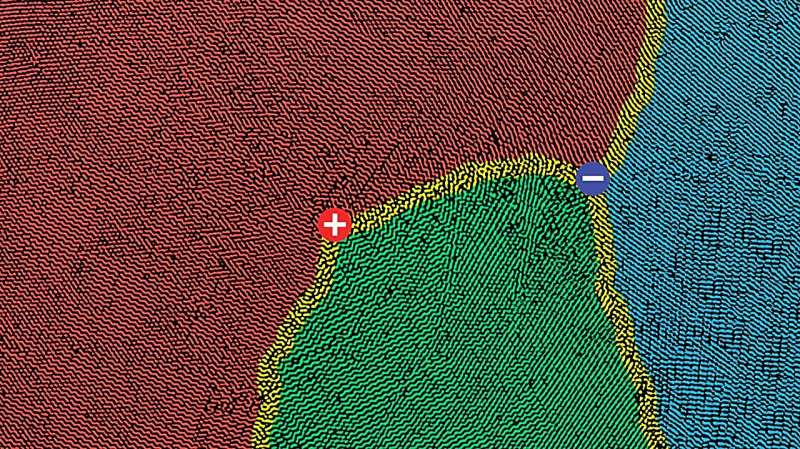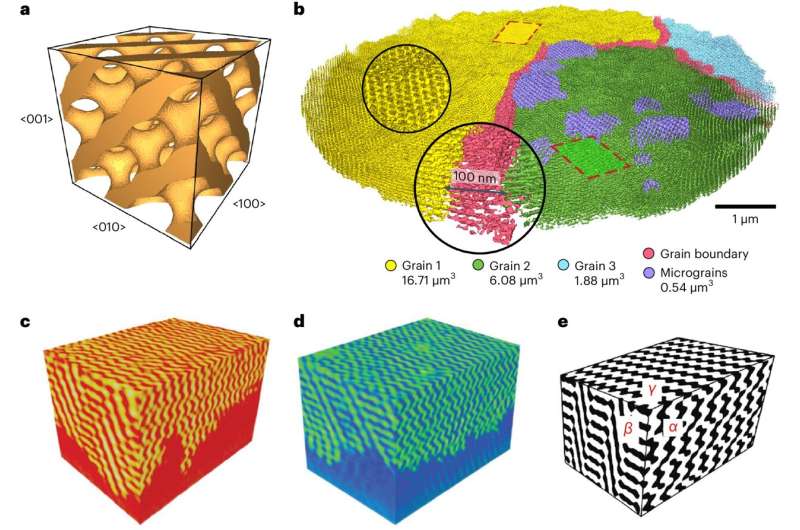This article has been reviewed according to Science X's editorial process and policies. Editors have highlighted the following attributes while ensuring the content's credibility:
fact-checked
peer-reviewed publication
trusted source
proofread
New 3D reconstruction method aids analysis of property-defining defects

An international research collaboration, including a group from Cornell Engineering, has applied a new X-ray-based reconstruction technique to observe, for the first time, topological defects in a nanoscale self-assembly-based cubic network structure of a polymer-metal composite material imaged over a relatively large sample volume.
In the future, this technique and new materials insights could be applied to the study of other mesoscale structures exhibiting this class of defects—which are known to underpin many known physical phenomena and can spawn new or enhanced material properties—in self-assembled materials, both natural and synthetic.
"It's a new polymer, a new structure and a new technique that allowed for unprecedented sample volumes to be reconstructed," said Ulrich Wiesner, the Spencer T. Olin Professor in the Department of Materials Science and Engineering. "That's really the key: If you have 70,000 unit cells of a material, instead of only tens of unit cells, you can really start to look carefully at the defect structure—what type of defects and how often these defects occur?"
Wiesner is co-author of "High-resolution Three-dimensional Imaging of Topological Textures in Nanoscale Single-diamond Networks," which was published July 23 in Nature Nanotechnology. The corresponding author is Justin Llandro, assistant professor at the Research Institute of Electrical Communication at Tohoku University, in Sendai, Japan.
Wiesner—whose research group has been working on block co-polymer self-assembly (BCP SA) since he arrived at Cornell 25 years ago—oversaw synthesis of the triblock terpolymer material used in the study. Synthesis was conducted by Takeshi Yuasa and Hiroaki Sai, both former members of the Wiesner Group.
The question regarding the importance of defects in BCP SA-generated materials has always been elusive, Wiesner said, in part because technologies necessary to measure large-enough sample volumes—with correspondingly larger defect structures—have been slow to develop.

The new technology—hard X-ray ptychography, which was conducted at the Swiss Light Source (SLS), at the Paul Scherrer Institute in Switzerland—is an advanced form of tomography that can penetrate deeper into a material than is possible with beams in electron microscopes. This technique allowed the researchers to reconstruct a very large sample volume of a BCP SA-derived polymer-metal composite material.
"If you have a smaller defect such as a line or a point defect, when you perturb the system, often you can 'correct' the defect structure," Wiesner said. "In contrast, topological defects are so large, they are very stable against external perturbations."
Once the triblock terpolymer was synthesized, researchers in the group of Ulli Steiner at the Adolphe Merkle Institute in Fribourg, Switzerland, a long-time collaborator of Wiesner, generated thin films from it and replaced one of the terpolymer blocks with gold, so the material could withstand repeated exposure to the intense coherent X-ray beams at SLS.
Imaging and image reconstruction at the SLS finally revealed a co-continuous network known as a single-diamond structure, with topological defects that the researchers expect would have substantial effects on mechanical and other properties. Importantly, the defects most closely resemble topological textures found in nematic liquid crystals and in Hydra single-celled organisms, suggesting that self-assembly can be used as a model process to investigate the role of topology in nature.
Wiesner said this collaborative research could pave the way for future studies in an area that his lab has already explored: block copolymer-directed superconductors.
"You would expect that your macroscopic, electronic or transport properties of the superconductor will depend on defects in your materials," he said. "That's what I'm really excited about: Now we have a technique that allows us to visualize larger volumes of these materials and to generate defect structure—property correlations."
Other collaborators came from the Paul Scherrer Institute, the Adolphe Merkle Institute of the University of Fribourg, both in Switzerland; the Max Planck Institute for Chemical Physics of Solids, in Dresden, Germany; the University of Salzburg, Austria; Hiroshima University and the Inamori Research Institute for Science, Kyoto, both in Japan.
More information: D. Karpov et al, High-resolution three-dimensional imaging of topological textures in nanoscale single-diamond networks, Nature Nanotechnology (2024). DOI: 10.1038/s41565-024-01735-w
Journal information: Nature Nanotechnology
Provided by Cornell University





















